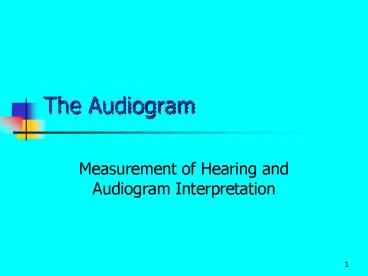The Audiogram PowerPoint PPT Presentation
1 / 38
Title: The Audiogram
1
The Audiogram
- Measurement of Hearing and Audiogram
Interpretation
2
Introduction
- How we measure hearing
- How those measurements can be recorded
- What the audiogram can tell us
3
Purposes of audiometric testing
- Monitor the effectiveness of the hearing
conservation program - Identify significant threshold shift
- Establish readiness and fitness for duty
- Ensure proper referral and diagnosis
4
Vocabulary
- Audiogram - A record of a persons pure-tone
hearing threshold levels - Threshold A level of sound that a person can
detect 50 of the time or more - Audiometric Zero sensitivity of normal, young
adults
5
Audiometric Zero (Ref ANSI S3.6 1996, TDH-39
earphones) 0 dB Hearing Level at
1000 Hz 7 dB SPL
6
- Does 0 dB HL mean the absence of sound?
- What is the intensity of a 0 dB HL pure-tone at
1000 Hz?
7
Output Limits of the DOEHRS-HC Audiometer
- -10 to 100 dB HL
8
Serial Audiogram
- Thresholds recorded to the nearest
- 5 dB
- Used on DD Forms 2215 and 2216, entrance
physicals and physical exam forms (SF 88 and DD
2808)
9
Serial Audiogram
10
Graphic Audiograms
- Provides a pictorial representation of hearing
thresholds as a function of frequency and
intensity - Uses symbols and/or colors to represent right
ear, left ear, bone conduction hearing and
masking levels
11
Graphic Audiograms
12
Self-recording Audiogram
13
Degrees of Hearing Loss
- Normal Hearing -10 - 25 dB HL
- Mild Hearing Loss 30 - 45 dB HL
- Moderate Hearing Loss 50 - 65 dB HL
- Severe Hearing Loss 70 - 85 dB HL
- Profound Hearing Loss gt 90 dB HL
14
Audiogram Configurations Progressive
noise-induced hearing loss
15
Hearing Loss Zones
16
Speech Sounds
Hz
250 500 1000 2000 3000 4000
6000 8000
f
th
s
p h
k
ch
sh
dB
17
Audiogram Configurations Gundecking
18
Audiogram Configurations Background Noise
19
Cross-over
- One ear hears much better than the other
- The sound presented to the test
ear crosses through the skull
and stimulates the
hair cells of the
cochlea of the non-test ear - The non-test ear is the one actually
responding to the tone - Differences of gt 40 dB at the same frequency
between ears are suspicious
20
Cross-over
21
Malingering
- Pretending to have a hearing loss by waiting
until the sound is quite loud before pressing the
response button - IAW Article 115, Paragraph 194, a person may be
charged with malingering if he/she pretends to
have a hearing loss that is later found to be
non-existent
22
Automatic Rechecks
23
Sensorineural Hearing Loss
- Determined by a complete audiological evaluation
- Compare air-conduction and bone-conduction
pure-tone thresholds - Look at acoustic immittance test results
24
Sensorineural Hearing Loss
25
Conductive Hearing Loss
26
Counseling Patients
27
Explain the Test Results
- Provide privacy for explanation
- Both ears tested
- Frequencies tested
- The lower the threshold, the better the hearing
- Review each ear in terms of intensity and
frequency
28
Appropriate Explanations
- Within normal limits
- Loss in the high or low frequencies
- Loss in one or both ears
- Hearing has changed or remained the same
29
Making Diagnoses
30
- Medical Legal Requirements Regardless
of Type - Patients name, SSN, (MOS, SSI, Job Location, and
Unit Identification Code) - Examiners name, SSN, and certification number
- Date of Test
- Make, model, and serial number of audiometer
- Calibration date of audiometer.
31
DOEHRS-HC supplies most of the necessary medical
legal audiogram informationAUTOMATICALLY
32
DD Form 2215 Reference Audiogram
- For all military and noise-exposed civilians
- Performed before noise-hazardous duties or as
soon as possible thereafter - Noise-free period of at least 14 hours before the
test - No temporary ENT problems the day of test
- Refer for low-frequency or high-frequency hearing
loss - After a permanent STS, re-establish a new
baseline
33
DD Form 2216 Hearing Conservation Data
- Periodic audiogram
- Annual
- 90 - Day
- Termination
- Other
34
Forms General Information
- Maintain audiograms for entire period of
employment plus 5 years - Test must be performed by audiologist, physician,
persons certified by CAOHC, or one who has
received equivalent military training - Equivalent military training includes this
course. The certification from this course and
other Army courses is only 5 years
35
Audiogram Review
- Trained personnel must review all audiograms
for validity and proper patient disposition. - Who Reviews?
- Initially any Hearing Conservation Technician
- Problem audiograms must be reviewed by an
audiologist, otolaryngologist or other physician
36
Audiograms to Refer
- DD 2215s
- gt 25 dB at 500, 1000, and 2000 Hz
- gt 55 dB at 3000, 4000, or 6000 Hz
- DD 2216s
- Significant Threshold Shift (STS) computed from
the average of 2000, 3000, 4000 Hz in either
ear in comparison to the baseline or reference
hearing test (DD2215)
37
Factors Affecting Validity
- Poor test environment - audiometric test booth
does not meet background noise criteria - Cross-over hearing
- Uncooperative patients
38
Review Questions
- Does an audiometric booth need to be perfectly
soundproof? - Excessive noise in an audiometric test booth will
probably effect which frequency? - When hearing levels between ears at the same
frequency differ by 50 to 70 dB, what should you
suspect is going on?

